Our goal is to establish the baseline of an operating Biological Life Support System. The idea that a person might board the M.A.S.H., and (theoretically) never have to depart. Power, Air, Water, Food, and Waste processing would all take place on board – without the need for inputs, or outputs.
Realistically, we do not expect to achieve the goal of a fully closed system until Phase 4. However, demonstrating the interactions, and cooperation possible with the Biome design would be very nice, indeed.
ACQUISITION

In 2017 an 84 passenger school bus was purchased from a school in Arizona. The bus would not start, but the vehicle was in good condition otherwise. It had not been moved in 5 years, yet the tires seemed in equally good condition. Upon purchase, the bus was towed to a mechanic in a nearby town and the engine and drive train evaluated, and made road worthy. The bus was driven to a residential area that would be its home for the years it would take to gut, and construct the initial rooms and infrastructure.
REFIT
The interior of the bus is divided into four rooms. At the front, with the driver’s chair, is the dining area with seating for four, and the Power System.
The next room would house our kitchenette on the starboard side, and a workshop on the other.
Room three is the living quarters, with water system components and heater.
Room four at the rear, and over the engine, is the Life Support Room. It houses the
composting toilet, the fish pond (300 gal) on the starboard side. Along the back wall is a shelf for the chicken coop. On the port side is the garden. In the center of the ceiling is a hatch with a stair for roof access.
POWER
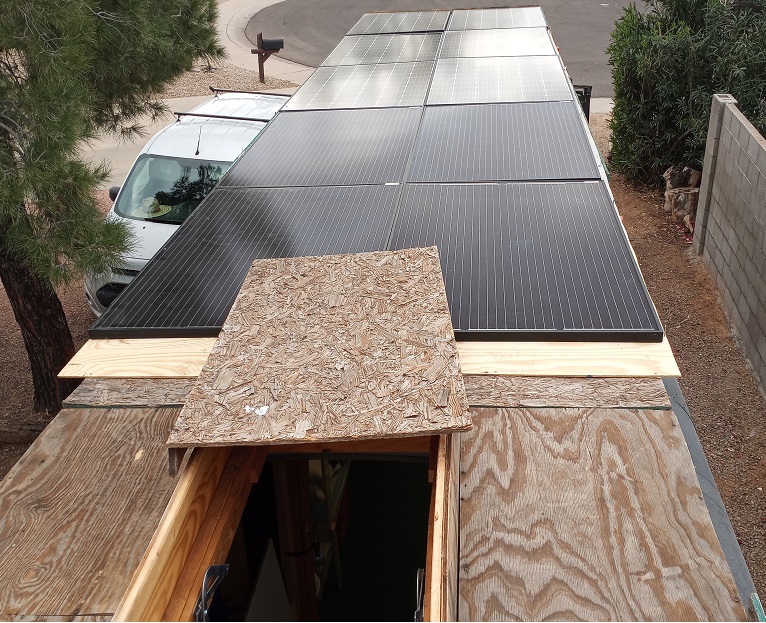
Panels: Power is generated by 20, 300-watt solar panels, for a maximum of 6 kilowatts of electricity. Ten panels are on the roof, 5 panels on the exterior of each side wall. They feed as 5 strings of 4 panels each into the 5,000 watt Power Center.
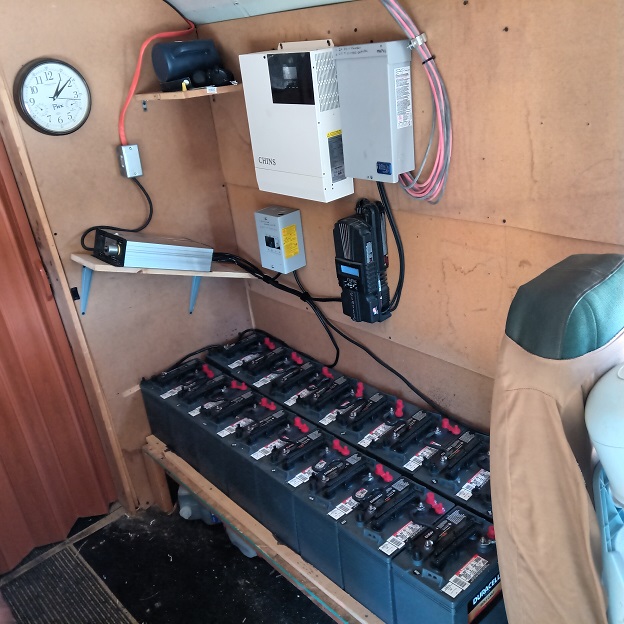
Power Center: The Power Center provides charge to the 48v battery pack, and converts the 48v energy into 120v house current to power all the circuits within the M.A.S.H.
Generator: A 1300w run/2300w peak generator with Bluetooth connectivity is available to provide backup generation in the event of inclement weather. While the generator has not been needed for the past three months, we still run it every two weeks to assure its continued functionality.
THE LIFE SUPPORT SYSTEM
The life support system has four major components: Air, Water, Food, and Waste
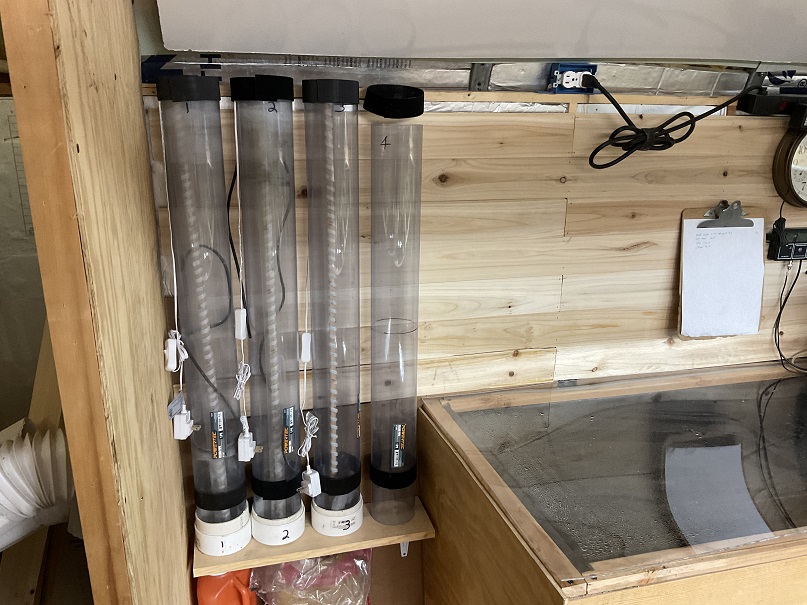
I – AIR: Photo Bioreactors: Four 36″, 4″ diameter acrylic tubes with a center lighting source, and air bubbler in the bottom facilitate the growth of cyanobacteria. The cyanobacteria photosynthesize, feeding on CO2 and pond water, and release O2 into the air. Harvested cyanobacteria provide one component of the fish/chicken feed.
II – WATER: Water is processed in two loops. The Aquaponics or Pond loop, between the fish, chickens, and garden; and the Potable Water loop.
Fish Pond: The pond is designed for edible fish, and with 300 gallons, can theoretically handle up to 150 fish in varying stages of growth, though our current population rests at 52 tilapia. Within the pond is installed a circulator to maintain a constant circulation within the pond. The water quality is stable, with pH hovering around 7.6 with temperatures currently fluctuating from 60f in the early morning to 75-80f by the mid-afternoon.
Potable Water Loop: Water is used by crew for drinking, showering, cleaning, and topping off the pond. These processes flow into the grey water tank. The grey water is then pumped up to the swamp where snails, fresh water shrimp, and bog plants prepare the water for the garden. This water is used to replenish the supply.
III – Food: Food for humans is provided as Fish in the Pond, eggs from the quail, and Vegetables from the Garden. Feed products are provided for the fish and chickens, i.e. algae from the PBRs, larvae from the compost, Worms from the worm bin, and Duckweed from the garden.
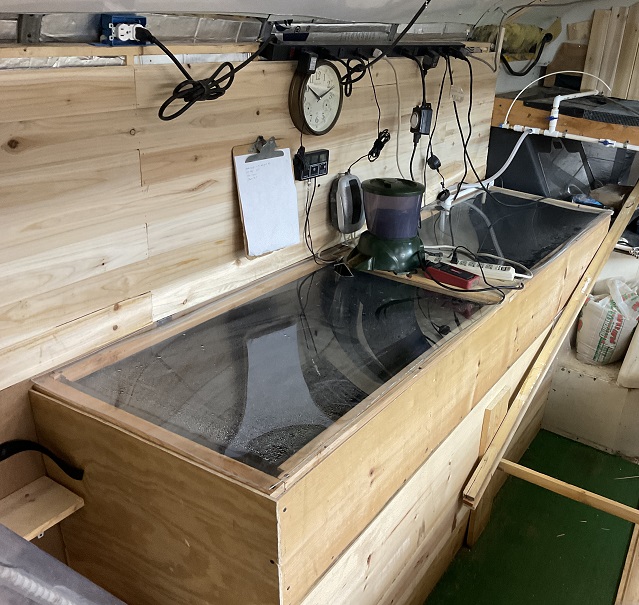
Fish Pond – We have chosen Tilapia as our primary fish, and currently house 52 fish. The plan is to add additional tilapia, and some catfish this summer bringing our population up to around 100 fish.
Every hour, a timer engages the pump in the pond to flow up to a marsh. the marsh is divided such that a 22ft long channel is formed to provide maximum time for settling of fish solids. Quail rest in a cage above the marsh allowing the quail waste to contribute additional fertilizer. A second channel carries pond water to the top of four algae tube Photo-Bioreactors that produce oxygen, and feed for quail and fish.
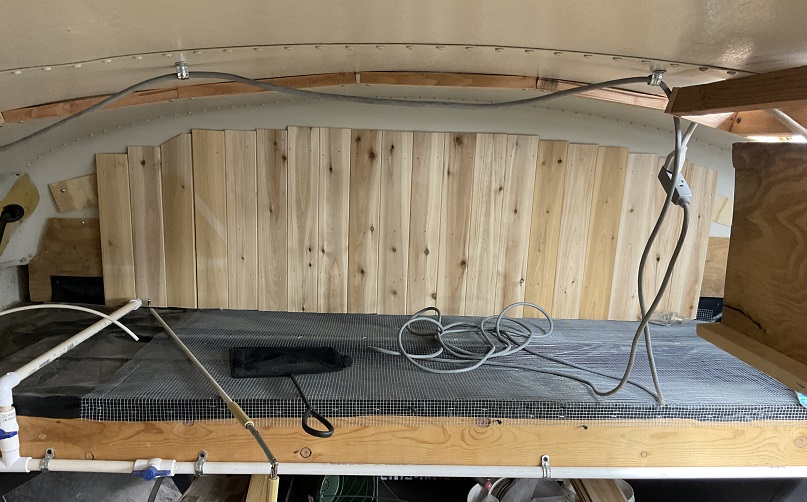
Quail Coop: Currently the coop floor is complete, with a portion of the pond water flowing through it, and draining down a corrugated metal wall and into the garden. We are planning on hosting 6 laying hens, and cycling rolling stock of 10 meat birds.
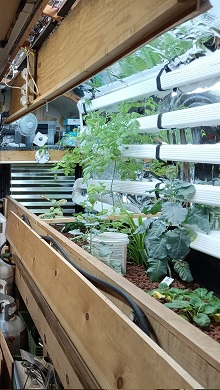
The Garden: The garden or media bed provides home to fruiting crops (such as tomatoes, peppers, beans, brussels sprouts, and broccoli), and root crops (such as potatoes, onions, radishes,
and carrots) in addition to the traditional leaf crops of lettuce, cabbage, and herbs.
IV – Waste: Solid wastes, i.e. human and garden wastes are deposited in A DIY composting toilet that is emptied weekly, and an portion of larvae contents are harvested for feed.
A worm bin is maintained where kitchen waste, ground egg shells, ground banana peels and other natural fertilizer components are added. Worms are periodically harvested for feed.
Urine is captured separately, and cycled to a solar distillery, then through a mineralization filter, and finally through a UV sterilizer before returning to the fresh water tank.
SUMMARY
The MASH represents a working test-bed for multiple technologies in the Mobile Analog Space Habitat. We are working to demonstrate sustainable, and regenerative living on board.
This Analog travels to shows, libraries, and community exhibitions to allow hands on experiences to the public with the technologies that we will be applying in our settlements on our rocky neighbors.